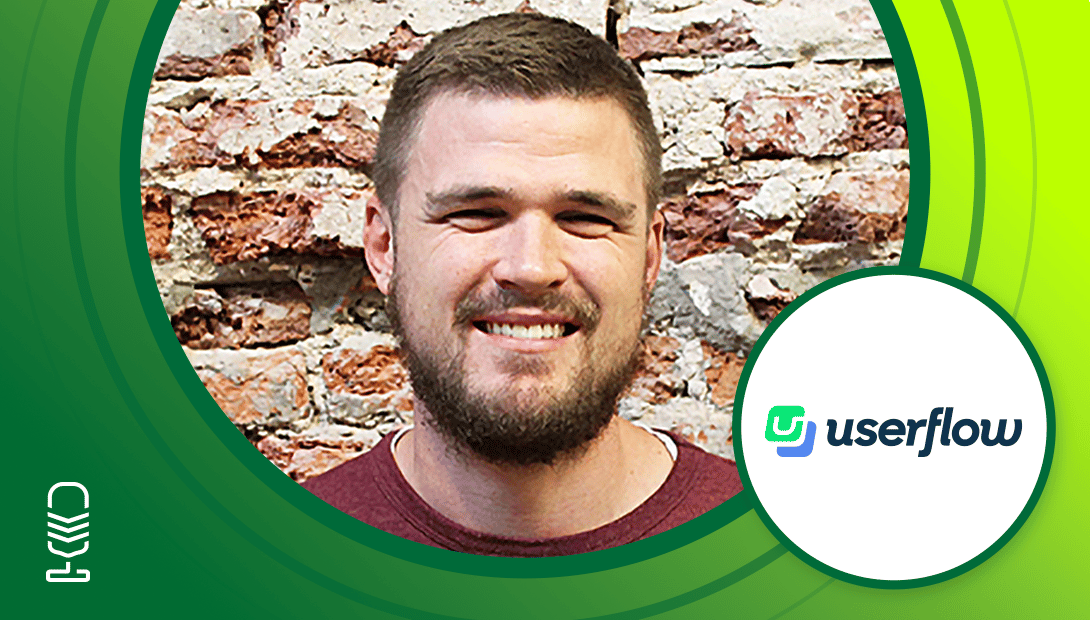Fuel Growth Podcast: Finding the Winning Self-Service Secret with Esben Friis-Jensen, Userflow
There’s no denying it, B2B companies are currently experiencing a massive shift in how people buy and use software. In fact, Forrester looked into the subject and found that nearly 75% of B2B buyers said they’d rather buy via an app or website than through a salesperson. This shift has pushed companies to embrace new selling models, such as product-led growth, in response to that—a topic we actually dove into today.
On this episode of the Fuel Growth podcast series, my co-host Lizzy and I met with Esben Friis-Jensen, co-founder and Chief Growth Officer of Userflow. Userflow is a B2B software company delivering simple tools that allow organizations to build highly customized and dynamic workflows to simplify and automate customer onboarding processes for software companies.
For Esben, product-led strategies and models made the most sense for his companies, which in turn sparked a passion for him in the field. After years of practice, Esben came on our podcast to share six practical steps you can take today to become product-led and the top three biggest mistakes he’s seen companies make during the shift.
6 Practical Steps You Can Take Today to Become Product-Led.
AUDIOGRAM: What IS Product-Led Growth?
1. Create a ‘Culture of Change’ for Your Organization
Building flexibility and agility into your culture is a wise investment when it comes to your organization’s future—especially if you’re on the verge of experiencing an explosion in growth. Esben went on to say, “it needs to start with the management. If management doesn’t buy into why you’re doing this, then forget about it. They need to say, ‘okay, this is what we’re doing. We need to become more product-led’. And then the rest of the management team needs to buy into that. Because it’s really a cross-functional initiative, and if that doesn’t come from the top, it’s not going to happen, or at least move very slowly.”
Everyone, from c-suite to rep, needs to subscribe to an adaptable mindset to be able to pivot plans on a moment’s notice—it’s the only way to meet emerging market and customer needs.
2. Reduce Your Scope
Define early on what you’re going to do and stick to it. Esben related this back to his experience at a previous company where “we said that we only wanted to start doing product-led for our smallest customers. They were the ones with the simplest use case, which created more transactional buyers. Even though they were paying a subscription, it was much more transactional. And for those, you can easily build a simple product-led workflow to create a more self-serve product experience. So, in that way, you could reduce the scope. Even though you think, ‘we should probably expand this to everyone’, but by making it very focused, we didn’t scare the organization”.
It pays to understand the real business need, higher-level goals, and business objectives of a project. You don’t need to be everything to everybody. Define your growth goals, show how you will hit them, and then do that. Don’t add more to your plate if you don’t need to.
3. Don’t Overanalyze
Whatever you do, don’t go down the rabbit hole when it comes to putting together your product plans. Esben stated, “the most common thing with these changes is you end up in ‘analysis paralysis. People will try to measure everything down to the last detail. ‘Let’s do an experiment’. ‘Let’s measure it,’ ‘Let’s do another experiment’. When it happens, it becomes too much, and you never move forward. Look at what others are already doing. If other successful SaaS businesses are doing it, you can do it too. Most SaaS business offerings are very similar; if something is working for you or someone else in your industry, try that”.
Stop overanalyzing, start executing.
4. Listen to Your Customers
Customers are typically quite vocal—listen to them. Unfortunately, in a sales-led model, you unintentionally create distance between your customers and the people designing your products. Esben stated, “you still grow with a sales-led approach, but the teams closest to your customers are the Customer Success Managers and salespeople. Sales then becomes responsible for communicating feedback all the way back to product managers, UX designers, and end developers—and in that chain of communication, a lot of stuff can get lost in translation”.
Larger organizations, especially sales-led organizations, should keep in mind how they can put their product team closer to the customers. According to Esben, “I think that’s a problem many software companies have today. I do believe that the ‘Lost in Translation’ thing is very real when you have customer success managers or sales on the frontline. They often don’t know how to communicate in ways that the product or UX team will understand in order to make impactful changes for the customer”. When you place your product teams directly in front of customers, it creates a more stable line of communication for design teams to listen and learn. This in turn increases the likeliness of delivering a product that solves their customer’s problems.
5. Take Risks
Simply put, don’t be afraid. Esben said this best when stated, “take risks based on what you’re seeing others are doing. If others are doing it, why shouldn’t you be able to do it? One thing we did great at Cobalt was that we mapped out our entire end-to-end process for our Go-To-Market (GTM) plan—everything from how we sell to how we onboard to how we do everything in between. And in doing that, we decided that at certain steps the customers can self-serve instead of relying on a person from our company to help them. It was like a hand-holding step. From there, we just started from scratch and looked at where we could replace these hand-holding steps. Like, sometimes you are doing high-touch just to do high-touch or doing it because that’s what you’ve always done—you don’t believe the customer can actually do stuff on their own. I think you need to take that leap of faith that some customers can do stuff on their own, as long as you have the capability for them to do it on their own”.
6. Lean on Product Marketing
With this new trend of product-led growth in the SaaS industry, old marketing and sales rulebooks are being turned upside down. Product marketing is a large part of this shift.
Esben said, “product marketing is basically a marketing team that’s hyper-focused on using the product in the marketing, right? Like, how can we market the products to the world and not just talk about the ‘why’, such as vision or high-level things”. He went on to say, “everybody knows the ‘why’, but how do you solve my issues? How are you doing it better? Why are you better than the rest? That’s what people want to know. And that’s something product marketers are very focused on. I think we’re going see product marketing become the dominant force in marketing”.
Centering your marketing around the product and the tangible outcomes your product will deliver is critical to putting strong tailwinds behind product-led growth.
Top 3 Biggest Mistakes You Can Make While Growing a Company
1. Forgetting the Importance of Onboarding Your Customers
The first mistake Esben has seen firsthand is companies celebrating the sale and forgetting the importance of making sure the customer has a smooth implementation process. He stated, “if you move to a product-led model, you will most likely have self-service. But you still need to onboard your customers; you still need to show them the value of your product. If you’re too focused on the initial sale, you’re not focused on driving the user to the ‘aha moments’, or the value realization”.
You want to create a customer for life, not just a one-time sale—and that starts after the dotted line is signed.
2. Letting the Friction Fester
The second mistake people make is not addressing the elephant in the room—friction. Esben stated, “this goes back to fear, especially sales-led companies moving to product-led growth. They tend to add unnecessary friction because they think all those sales-led processes were there for a reason. But they were not always there for a reason. They were there because people were involved—and then you added complexity. But sometimes you should just remove steps, right?”. By removing certain layers of unnecessary processes, you can decrease the amount of friction customers, and employees alike feel during the buying and selling process.
3. Not Addressing Internal Resistance When It Comes to Culture Change.
By its very nature, uncertainty is created when organizations start to implement changes in their plan and processes. Esben stated, “resistance can come from sales teams or customer success teams because they will feel like they’re being replaced. And that’s where change management is super important because they’re not necessarily getting replaced. In many SaaS companies and larger SaaS organizations, they still have sales teams and customer success managers, they’re just doing different stuff. They’re doing more high-value stuff, like focusing on customer needs or prioritizing customers that are maybe struggling”. Remind your employees that they’re not being replaced, you’re just automating manual tasks so you can free up their time to do more rewarding and fulfilling things”.
Shifting Selling Methods: Not as Hard as You Would Think!
Whether you’re a startup just getting its bearings, or an established company looking to switch things up to respond to your changing customer base, product-led selling models can be the right move for you. But it all starts with transparency and getting everyone on the same page.
Many companies have successfully moved from high-touch and high-friction sales models to a product-led approach. In fact, according to the Product-Led Growth Benchmarks 2022 report, 91% of surveyed companies are planning to invest more in product-led initiatives this year, while 58% of B2B technology companies already have a product-led plan in place.
Want to learn more about how you can seamlessly make the switch? Listen to our full podcast conversation here for a more in-depth look into how switching to a product-led sales model can be your golden ticket to acquiring, retaining, and growing your customer portfolio. If you want to catch up on our previous episodes, you can do so here or on your favorite podcast app.

